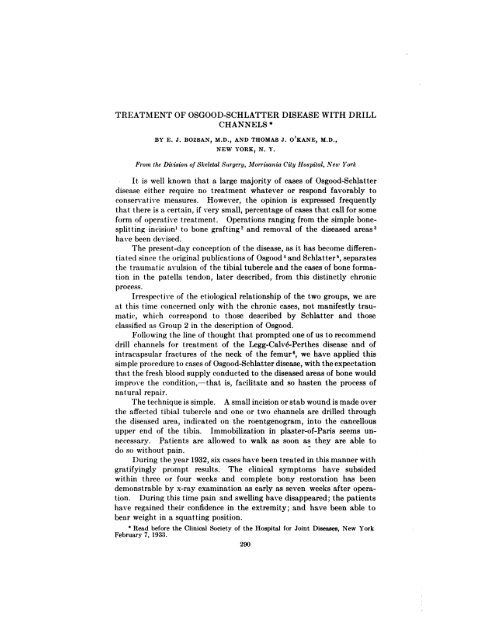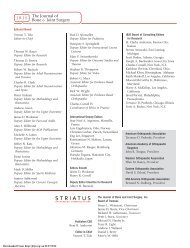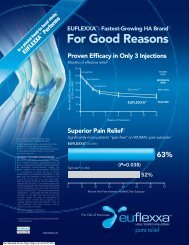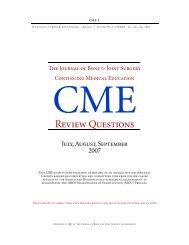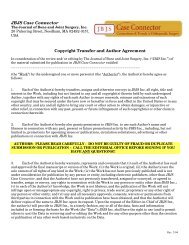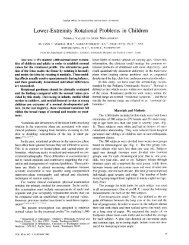TREATMENT OF OSGOOD-SCHLATTER DISEASE WITH DRILL ...
TREATMENT OF OSGOOD-SCHLATTER DISEASE WITH DRILL ...
TREATMENT OF OSGOOD-SCHLATTER DISEASE WITH DRILL ...
Create successful ePaper yourself
Turn your PDF publications into a flip-book with our unique Google optimized e-Paper software.
<strong>TREATMENT</strong> <strong>OF</strong> <strong>OSGOOD</strong>-<strong>SCHLATTER</strong> <strong>DISEASE</strong> <strong>WITH</strong> <strong>DRILL</strong><br />
CHANNELS *<br />
BY E. J. BOZSAN, M.D., AND THOMAS J. O’KANE, M.D.,<br />
NEW YORK, N. Y.<br />
From. the Division of Skeletal Surgery, Morrisania City Hospital, New York<br />
It is well known that a large majority of cases of Osgood-Schiatter<br />
disease either require no treatment whatever or respond favorably to<br />
conservat ive measures. However, the opinion is expressed frequently<br />
that. there is a certain, if very small, percentage of cases that call for some<br />
form of operative treatment. Operations ranging from the simple bone-<br />
splitting incision1 to bone grafting2 and removal of the diseased areas3<br />
have been devised.<br />
The present-day conception of the disease, as it has become differen-<br />
tiated since the original publications of Osgood4 and Schlatter5, separates<br />
the traumatic avulsion of the tibial tubercle and the cases of bone formation<br />
in the patella tendon, lat.er described, from this distinctly chronic<br />
process.<br />
Irrespective of the etiological relationship of the two groups, we are<br />
at. this time concerned only with the chronic cases, not manifestly trau-<br />
matic, which correspond to those described by Schiatter and those<br />
classified as Group 2 in the description of Osgood.<br />
Following the line of thought that prompted one of us to recommend<br />
drill channels for treatment of the Legg-Calv&Perthes disease and of<br />
intracapsular fractures of the neck of the femur6, we have applied this<br />
simple procedure to cases of Osgood-Schiatter disease, with the expectation<br />
that the fresh blood supply conducted to the diseased areas of bone would<br />
improve the condition,-that is, facilitate and so hasten the process of<br />
natural repair.<br />
The technique is simple. A small incision or stab wound is made over<br />
the affected t.ibial tubercie and one or two channels are drilled through<br />
the diseased area, indicated on the roentgenogram, into the cancellous<br />
upper end of the tibia. Immobilization in plaster-of-Paris seems un-<br />
necessary. Patients are allowed to walk as soon as they are able to<br />
do so without pain. -<br />
During the year 1932, six cases have been treated in this manner with<br />
gratifyingly prompt results. The clinical symptoms have subsided<br />
within three or four weeks and complete bony restoration has been<br />
demonstrable by x-ray examination as early as seven weeks after opera-<br />
tion. During this time pain and swelling have disappeared; the patients<br />
have regained their confidence in the extremity; and have been able to<br />
bear weight in a squatting position.<br />
* Read before the Clinical Society of the Hospital for Joint Diseases, New York<br />
February 7, 1933.<br />
290
<strong>OSGOOD</strong>-<strong>SCHLATTER</strong> <strong>DISEASE</strong><br />
LJ<br />
WH<br />
“<br />
;,<br />
291<br />
o. - . -<br />
-I.<br />
-<br />
-<br />
-<br />
1.<br />
H
292 E. J. BOZSAN AN!) T. J. 0 KANE<br />
(.‘ASE HISTORIES<br />
CASE 1 (Figs. 1, 2, and 3). 13. S., girl, eleven years of age (No. 29529), was admitted<br />
to the hospital January 13, 1932. Symptoms of pain and tenderness had been present<br />
for six months. Roent.genogram taken the following day (Fig. 1 ) revealed the tubercle<br />
fragmented and considerably absorbed. Drilling operation was performed on February<br />
I , 1932. On withdrawal of the (trill, a large (lrop of mucilaginous material issue(1 out of<br />
the hole un(ler some l)resstlre. Cultures of this and hone chips were negative. Due<br />
to the fact that this patient had to he placed in a plaster spica on account of a coexisting<br />
process in the hip joint, the earliest postoperative roentgenogram could not be taken<br />
until<br />
-<br />
May 7, 1932 (Fig. 2 . This<br />
A<br />
indicated<br />
r<br />
complete restoration of the tibial tubercle,<br />
and a follow-up picture July 5,<br />
1932, (Fig. 3) showed tip fused<br />
. with main l)ody of the tibia.<br />
CASE 2 (Figs. 4, 5, 6, and<br />
7). E. Q., boy, aged fifteen<br />
years (No. 28026), had been<br />
treated in the Out-Patient<br />
Department since the fall of<br />
1931. Symptoms had been<br />
present vi Ith varying intensity<br />
for the last fourteen months.<br />
Roentgenogram December 7,<br />
1931, (Fig. 4) showed the tubercle<br />
fragmented and its tip absorbed.<br />
Patient refused opera-<br />
t.ion but returned in the spring<br />
of 1932 on account of exacerha-<br />
t.ion of symptoms. X-ray (Fig.<br />
5) April 26, 1932, revealed iden-<br />
tical condition as four and one-<br />
half months before. Drilling<br />
operation was done on May 6,<br />
1932, and the limb immobilized<br />
for two weeks. Patient was<br />
discharged May 30, 1932.<br />
When he reported to the clinic<br />
about eight. weeks after 1eration,<br />
July 1, 1932, the roentgenogram<br />
(Fig. 6) revealed the<br />
previously absorbed tip of the<br />
FIG. 4 tibial tubercle restored. All<br />
clinical symptoms were absent<br />
Case 2. Roent.genogram taken December 7, 1931.<br />
Tihial tubercle fragmented and tip absorbed. and the patient had full use of<br />
the limb. He did not report<br />
again until March 20, 1933, on which occasion the x-ray (Fig. 7) revealed complete resto-<br />
ration of the tihial t.iibercle and union of the small fragments with the main body of the<br />
tuhercle, with only a small hiatus indicating the upper border of the small fragment. He<br />
was completely free of symptoms.<br />
CASE 3 (Figs. 8, 9, 10, and 11). J. R., boy, fourteen years old (No. 31847). Symptoms<br />
had been present for five months previous to admission. X-ray September 8, 1932,<br />
revealed the tip of the right tihial t.uhercle absorbed. Operation was performed September<br />
19, 1932, and patient was discharged two days after operation with plaster-of-Paris<br />
bandage which he wore for a period of two weeks. About eight weeks after operation
<strong>OSGOOD</strong>-<strong>SCHLATTER</strong> <strong>DISEASE</strong> 293<br />
L<br />
4.<br />
I-<br />
-.,7<br />
i .<br />
. -<br />
.<br />
12<br />
C..
294 li. J. BOZSAN AND T. J. O’KANE<br />
FIG. S FIG. 9<br />
Case 3. Roentgeiiogram taken Septenhl)er<br />
5, 1932. Tip of t uherele<br />
ahsorhed.<br />
Case 3. Roentgenogram taken December<br />
3, 1932. Complete restoration.<br />
j<br />
Case 3. Roentgenogram taken November<br />
1, 1932, six weeks after operation.<br />
New hone fornmtion beginning.<br />
FIG. 11<br />
Case 3. Roentgenogram taken January<br />
12, 1933. Complete restoration,<br />
firm union.
FIG. 12<br />
Case 4. Hxentgenogram taken October<br />
14, 1932. Fragmentation and<br />
absorption of the tubercie.<br />
FIG. 14<br />
Case 5. Rnentgenogram taken December<br />
10, 1932. Tubercle fragmented<br />
and considerably absorbed.<br />
<strong>OSGOOD</strong>-<strong>SCHLATTER</strong> <strong>DISEASE</strong> 29s<br />
FIG. 13<br />
Case 4. Roentgenogram taken December<br />
1, 1932, seven weeks after operation.<br />
Complete restorat ion.<br />
FIG. 15<br />
Case 5. Roentgenogram taken February<br />
25, 1933, ten weeks after operation.<br />
Fragments united. Size of tubercle<br />
considerably increased.
296 E. J. BOZSAN AND T. J. O’KANE<br />
FIG. 16 FIG. 17<br />
Case 6. It()entgenogranl taken’De- Ca.se 6. Roentgenogram taken Febcember<br />
10, 1932. Tuberele fragmented ruary 25, 1933, ten weeks after operaaII(I<br />
rarefied. tion. Fragments united and size of<br />
tibial tubercle considerably increased.<br />
the boy viItS entirely free from clinical symptoms. Roentgenogram November 1, 1932<br />
(Fig. 9 revealed bone formation at the site of the previously absorbed tip and apposition<br />
of new bone over the body of the tuhercie. X-ray on December 3, 1932 ( Fig. 10) showed<br />
tibial tubercle totally restored, as did another (Fig. 1 1 ) taken January 12, 1933.<br />
CASE 4 (Figs. 12 and 13). \V. P., boy, thirteen years of age (No. 32670), had had<br />
symptoms for eight months. Roentgenogram (Fig. 12) taken on October 14, 1932<br />
revealed fragmentation and absorption of right tihial tuhercle. Operation was done on<br />
October 15, 1932, and patient. was discharged October 17, 1932, without application of<br />
plaster-of-Paris. On December 1, 1932, patient was free of all symptoms, and an x-ray<br />
(Fig. 13) at this time, seven weeks after operation, revealed complete bony restoration<br />
of the tibial tubercle.<br />
CAsE 5 (Figs. 14 and 15). .J. 5., boy fifteen years old (No. 34838). Symptoms<br />
had been present on 1)0th sides for eight. months. X-ray (Fig. 14) December 10, 1932,<br />
revealed diffuse absorption of the right tibia! tuhercle and a fracture at its base. Operation<br />
was performed on December 19, 1932, and patient was discharged December 21, 1932,<br />
without any immobilization. On February 25, 1933, the patient was free of symptoms,<br />
and roent.genogram (Fig. 15) taken at this time revealed bony formation, increasing the<br />
size of the tibia! tul)ercle, and union of fracture line.<br />
CASE 6 (Figs. 16 and 17). Same patient as Case 5. X-ray (Fig. 16) December 10,<br />
1932, revealed left tibial tubercie fragmented. Operation was done the same day as<br />
that on the right. side. When seen on February 25, 1933, the patient was free of symptoms.<br />
Roentgenogram at this time (Fig. 17) revealed considerable restoration of the<br />
outline of the tibia! tubercle and disappearance of the fragment.<br />
It is difficult to decide when to consider conservative measures in-<br />
adequate. The intensity of symptoms, the ensuing disability, and the
<strong>OSGOOD</strong>-<strong>SCHLATTER</strong> <strong>DISEASE</strong> 297<br />
period of recovery vary so widely that it seems futile to try to establish an<br />
average picture of the disease. Schlatter’s observation that the older the<br />
child, the better are the chances of spontaneous recovery is of little help<br />
in the great number of cases between the ages of eleven and fourteen.<br />
Osgood speaks of “severe handicap and long continued serious annoy-<br />
ance “, Schlatter of “recurrent attacks of pain over a long period of time”.<br />
Campbell7 mentions instances in which one or more years elapse before<br />
the symptoms entirely subside.<br />
We wish to emphasize that these are the cases, and these only, for<br />
which this simple operative procedure is recommended.<br />
REFERENCES<br />
1. JONES, SIR ROBERT, AND LovFrrr, R. W.: Orthopedic Surgery. Ed. 2. New York,<br />
William Wood and Co., p. 36, 1929.<br />
2. BOSWORTH, DAVID M.: Avulsion of the Tibia! Tubercle (Osgood-Schlatter) Treated<br />
by Fixation of the Tubercie with Bone Pegs. Section of Orthopedic Surgery, New<br />
York Academy of Medicine, Dec. 16, 1932.<br />
3. CorroN, F. J.: Fractures. In Dean Lewis’ Practice of Surgery. Hagerstown, Md.,<br />
W. F. Prior Co., Inc., Vol. II, Chap. 4, p. 127, 1927.<br />
4. <strong>OSGOOD</strong>, R. B.: Lesions of the Tibial Tubercle Occurring During Adolescence.<br />
Boston Med. and Surg. J., CXLVIII, 114, 1903.<br />
5. SCRLATFER, CARL: Verletzungen des SchnabelfOrmigen Fortsatzes der Oberen<br />
Tibiaepiphyse. Bruns’ Beitr. z. KIm. Chir., XXXVIII, 874, 1903.<br />
6. BOZSAN, E. J.: A New Treatment of Intracapsular Fractures of the Neck of the Femur<br />
and Calv#{233}-Legg-Perthes Disease. J. Bone and Joint Surg., XIV, 884, Oct. 1932.<br />
A New Treatment of Intracapsular Fractures of the Neck of the<br />
Femur and Legg-Calv#{233}-Perthes Disease. Technique. J. Bone and Joint Surg.,<br />
XVI, 75, Jan. 1934.<br />
7. CAMPBELL, WILLIS C.: A Text-Book on Orthopedic Surgery. Philadelphia, W. B.<br />
Saunders Co., p. 165, 1930.


